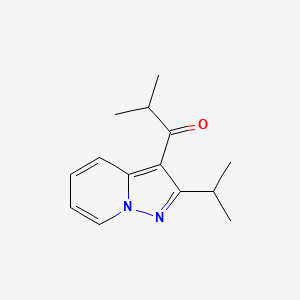



1. 1-(2-isopropylpyrazolo(1,5-a)pyridin-3-yl)-2-methyl-1-propanone
2. 1-(2-isopropylpyrazolo(1,5-alpha)pyridin-3-yl)-2-methyl-1-propanone
3. 3-isobutyryl-2-isopropylpyrazolo(1,5-a)pyridine
4. Av 411
5. Av-411
6. Av411
7. Kc 404
8. Kc-404
9. Mn-166
10. Mn166
1. 50847-11-5
2. Ketas
3. Kc-404
4. Mn-166
5. Ibudilastum
6. Ke Tas
7. Ibudilastum [latin]
8. Av-411
9. Ibudilast [inn:jan]
10. Eyevinal
11. Ketas (tn)
12. 2-methyl-1-(2-propan-2-ylpyrazolo[1,5-a]pyridin-3-yl)propan-1-one
13. 3-isobutyryl-2-isopropylpyrazolo[1,5-a]pyridine
14. Unii-m0tth61xc5
15. 1-(2-isopropylpyrazolo[1,5-a]pyridin-3-yl)-2-methylpropan-1-one
16. Av411
17. 3-isobutyryl-2-isopropylpyrazolo(1,5-a)pyridine
18. Tocris-1694
19. Lopac-i-0157
20. 1-propanone, 2-methyl-1-[2-(1-methylethyl)pyrazolo[1,5-a]pyridin-3-yl]-
21. 2-isopropyl-3-isobutyrylpyrazolo(1,5-a)pyridine
22. Mfcd00864808
23. M0tth61xc5
24. Chembl19449
25. Kc-404;av-411;mn-166
26. Ncgc00015542-05
27. 2-methyl-1-[2-(propan-2-yl)pyrazolo[1,5-a]pyridin-3-yl]propan-1-one
28. 1-propanone, 2-methyl-1-(2-(1-methylethyl)pyrazolo(1,5-a)pyridin-3-yl)-
29. Dsstox_cid_28933
30. Dsstox_rid_83199
31. 2-isopropyl-3-isobutyrylpyrazolo[1,5-a]pyridine
32. Dsstox_gsid_49007
33. Ibudilast (jan/inn)
34. Av 411
35. Cas-50847-11-5
36. Sr-01000075927
37. Brn 0656579
38. Pinatos
39. I0157_sigma
40. 1-(2-isopropylpyrazolo(1,5-a)pyridin-3-yl)-2-methyl-1-propanone
41. Ibudilast,(s)
42. Pyrazolo(1,5-a)pyridine, 3-isobutyryl-2-isopropyl-
43. Ibudilast [inn]
44. Ibudilast [jan]
45. Ibudilast [mi]
46. Ibudilast (jp17/inn)
47. Ibudilast [mart.]
48. I 0157
49. Ibudilast [who-dd]
50. Lopac0_000599
51. Schembl30390
52. 5-24-03-00396 (beilstein Handbook Reference)
53. Mls000862198
54. Gtpl7399
55. Zinc4234
56. Dtxsid7049007
57. Chebi:31684
58. Bcpp000209
59. Hms2089b21
60. Hms2233h08
61. Hms3261h20
62. Hms3268o11
63. Hms3374p02
64. Hms3412b20
65. Hms3676b20
66. Hms3715l09
67. Hms3886m03
68. Bcp02335
69. Hy-b0763
70. Tox21_113503
71. Tox21_500599
72. Bdbm50240404
73. S4837
74. Ibudilast, >=99% (hplc), Solid
75. Akos015895123
76. Tox21_113503_1
77. Ac-1044
78. Bcp9000768
79. Ccg-204688
80. Db05266
81. Lp00599
82. Sb19092
83. Sdccgsbi-0050581.p002
84. Ncgc00015542-01
85. Ncgc00015542-02
86. Ncgc00015542-03
87. Ncgc00015542-04
88. Ncgc00015542-06
89. Ncgc00015542-07
90. Ncgc00015542-17
91. Ncgc00025261-01
92. Ncgc00025261-02
93. Ncgc00025261-03
94. Ncgc00025261-04
95. Ncgc00261284-01
96. Smr000326961
97. Sy051343
98. Eu-0100599
99. Ft-0654591
100. Ft-0670255
101. I0740
102. D01385
103. F20666
104. Ab00698306-06
105. 3-isobutyryl-2-isopropyl-pyrazolo(1,5-a)pyridine
106. 847i115
107. A828320
108. H-20256
109. L003042
110. Q261167
111. J-512714
112. Sr-01000075927-1
113. Sr-01000075927-3
114. Sr-01000075927-6
115. Brd-k16444452-001-03-4
116. 1-(2-isopropylh-pyrazolo[1,5-a]pyridin-3-yl)-2-methylpropan-1-one
117. 1-(2-isopropyl-pyrazolo[1,5-a]pyridin-3-yl)-2-methyl-propan-1-one
118. 1-(2-isopropyl-pyrazolo[1,5-alpha]pyridin-3-yl)-2-methyl-propan-1-one
119. 1-(2-isopropylpyrazolo[1,5-alpha]pyridin-3-yl)-2-methylpropan-1-one
120. 2-methyl-1-(2-propan-2-yl-3-pyrazolo[1,5-a]pyridinyl)-1-propanone
121. 2-methyl-1-[2-(1-methylethyl)pyrazolo[1,5-a]pyridin-3-yl]-1-propanone
122. (ibudilast)1-(2-isopropyl-pyrazolo[1,5-a]pyridin-3-yl)-2-methyl-propan-1-one
123. 1-(2-isopropylpyrazolo(1,5-.alpha.)pyridin-3-yl)-2-methyl-1-propanone
124. 1-(2-isopropylpyrazolo[1,5-a]pyridin-3-yl)-2-methylpropan-1-one (ibudilast)
125. Avl
| Molecular Weight | 230.31 g/mol |
|---|---|
| Molecular Formula | C14H18N2O |
| XLogP3 | 3 |
| Hydrogen Bond Donor Count | 0 |
| Hydrogen Bond Acceptor Count | 2 |
| Rotatable Bond Count | 3 |
| Exact Mass | 230.141913202 g/mol |
| Monoisotopic Mass | 230.141913202 g/mol |
| Topological Polar Surface Area | 34.4 Ų |
| Heavy Atom Count | 17 |
| Formal Charge | 0 |
| Complexity | 288 |
| Isotope Atom Count | 0 |
| Defined Atom Stereocenter Count | 0 |
| Undefined Atom Stereocenter Count | 0 |
| Defined Bond Stereocenter Count | 0 |
| Undefined Bond Stereocenter Count | 0 |
| Covalently Bonded Unit Count | 1 |
For the treatment of multiple sclerosis, asthma, and cerebrovascular disease.
Vasodilator Agents
Drugs used to cause dilation of the blood vessels. (See all compounds classified as Vasodilator Agents.)
Platelet Aggregation Inhibitors
Drugs or agents which antagonize or impair any mechanism leading to blood platelet aggregation, whether during the phases of activation and shape change or following the dense-granule release reaction and stimulation of the prostaglandin-thromboxane system. (See all compounds classified as Platelet Aggregation Inhibitors.)
Bronchodilator Agents
Agents that cause an increase in the expansion of a bronchus or bronchial tubes. (See all compounds classified as Bronchodilator Agents.)
Phosphodiesterase Inhibitors
Compounds which inhibit or antagonize the biosynthesis or actions of phosphodiesterases. (See all compounds classified as Phosphodiesterase Inhibitors.)
R - Respiratory system
R03 - Drugs for obstructive airway diseases
R03D - Other systemic drugs for obstructive airway diseases
R03DC - Leukotriene receptor antagonists
R03DC04 - Ibudilast
19 hours
Ibudilast has mechanisms that include anti-inflammatory effects, such as phosphodiesterase inhibition, and neuroprotective effects, such as inhibition of [nitric oxide] synthesis and reduction in reactive oxygen species.
